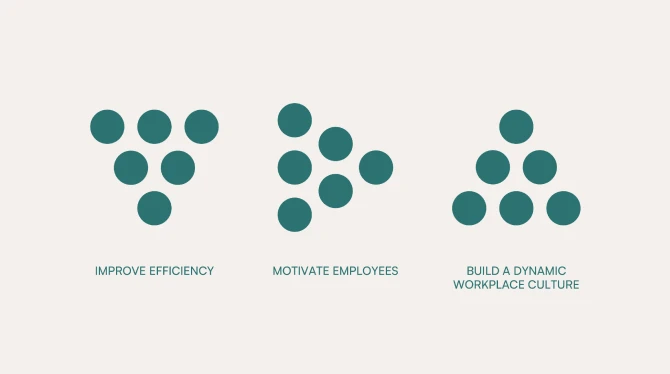🪃
How A Business Pivot Affects Your Digital Presence?
LAST UPDATED 17 May, 2024
In an ever-evolving business landscape, staying agile and adaptive is crucial. Pivoting can be a strategic move to maintain relevance, capture new markets, or leverage technological advancements. What does a pivot mean for your digital presence, and how can it be effectively managed?
How To Recognize That It’s Time For A Pivot
Business pivots often occur as a response to shifting market dynamics or internal growth avenues. Recognizing the need for a pivot is crucial – it often stems from indicators like stagnant sales, declining customer engagement, or increased competition. In some cases, a new product that revolutionizes the company vision can attract a different target group or change the revenue model.
Internal factors, such as a drop in employee morale or inefficiencies in current processes, can also indicate the need for change. These internal cues often precede external market pressures, offering signs that a pivot may be beneficial. Recognizing these signs early can be the difference between a proactive, strategic pivot and a reactive, forced change.
Learn more on how to recoginze it’s time for a pivot by scrolling down to the references section.1
Companies That Have Successfully Pivoted
- Twitter: Originally started as Odeo, a network where people could find and subscribe to podcasts, Twitter pivoted to become a microblogging platform that revolutionized real-time, short-form communication online.
- Groupon: Groupon began as The Point, a platform for organizing group actions, but pivoted to focus on group discounts and local deals, becoming a popular online coupon and deal marketplace.
- Starbucks: Initially a retailer of whole coffee beans and coffee-making equipment, Starbucks pivoted to become a café-style coffeehouse, focusing on the experience of enjoying coffee in a relaxing environment.
- HP (Hewlett-Packard): HP originally focused on electronic test products like audio oscillators but later pivoted to computing, becoming a significant player in personal computers and printers.
- Nintendo: Originally a playing card company, Nintendo pivoted over several decades through various industries, eventually finding monumental success in the electronic gaming market.2
Effects Of A Pivot Your Digital Presence
Brand Identity Transformation
A business pivot often leads to a rebranding effort. Changing your product offering changes your consumer structure. This means that you are talking to different people, so overall communication needs to be steered in a new direction that will render the pivot successful.
Digital Marketing Strategy
A business pivot demands a reevaluation of your digital marketing tactics. The goal is to ensure that all digital marketing efforts are in sync with the revised branding, effectively reaching and engaging the intended audience.
Content Strategy Revision
A content strategy overhaul entails a thorough revision of the topics, styles, and formats used across your digital platforms. The content, from blog posts to product descriptions, needs to reflect the new business focus and appeal to the updated target market.
Keyword Strategy Revision
Updating keywords is just the beginning. The content and metadata across your website need to be aligned and updated with the new business objectives. This strategic shift ensures that your online presence remains strong, adapting to the changing focus of the business while maintaining or improving search engine rankings. It’s a delicate balance between embracing the new and retaining the SEO gains made thus far.
Social Media Alignment
Finally, aligning your social media strategy with the pivot involves more than just updating posts, it’s about rethinking how you engage with your audience on these platforms. The tone, content, and even the frequency of posts may need to change to mirror the new direction of your business. It’s a strategic move to ensure that your social media presence supports and enhances the pivot, connecting with both existing and potential customers in meaningful ways.
User Experience Redesign
A business pivot often necessitates a nuanced redesign of the website’s UX to resonate with a shifted target audience or altered customer journey. This redesign is critical for enhancing user engagement and improving conversion rates. It involves a holistic reevaluation of the website’s interface, ensuring that the visual and navigational elements align seamlessly with the new business direction. Tailoring the new website to provide an intuitive, user-centric experience becomes paramount, especially when accommodating new products or services.
Simultaneously, modifications to the e-commerce platform are essential to support these shifting business goals. This includes integrating new features and payment methods that cater to the diverse needs of the new customer base. Upgrading platform functionalities not only streamlines the shopping experience but also fortifies customer trust through enhanced security measures. Altogether, these changes are pivotal in creating a cohesive digital environment that reflects the business’s evolved objectives.
Tracking And Technical
A business pivot can significantly alter the landscape of customer data analysis. Shifting focus or target markets means adapting the type and nature of data collected, impacting the customer acquisition experience. This adjustment is key to ensuring that data-driven decisions align with new business objectives and customer expectations.
Concurrently, customer support must evolve to address the nuances of new products or services. This involves not just updating knowledge bases and support scripts but also training customer service teams to understand and effectively respond to the new range of customer inquiries and needs.
Additionally, pivots often bring about necessary legal and compliance updates on the website. Introducing new products or venturing into new markets may require revisions to privacy policies, terms of service, and adherence to specific e-commerce regulations. Ensuring that these legal aspects are up-to-date is crucial for maintaining customer trust and avoiding potential legal pitfalls.
Execution – Steps, Costs, and Staff
Executing a business pivot requires a coordinated approach across various domains, involving substantial resource allocation and meticulous planning. Key steps include rebranding, digital marketing revisions, UX redesign, data strategy adjustments, and compliance updates.
- Rebranding: This foundational step involves redesigning the logo, updating the brand feel, modifying marketing materials, and brand collateral. Depending on the extent of rebranding, costs can range between $10,000 to $30,000, requiring collaboration between marketing experts and graphic designers.
- Digital Marketing and SEO Overhaul: Aligning digital marketing with the new brand direction involves revising SEO strategies, content, and advertising campaigns. Budgets for these activities may vary, but companies can expect to invest between $5,000 and $15,000 monthly by engaging SEO specialists, content creators, and digital marketing professionals.
- User Experience Redesign: Updating the website’s UX to improve engagement and conversion rates typically costs between $10,000 to $30,000. This task requires UX/UI designers and web developers who can create beautiful and intuitive user interfaces and seamless user experiences.
- Data Strategy and Compliance: Adapting customer data analysis and ensuring legal compliance are crucial. Data analysts and legal advisors are essential here, and costs depend on the scope but generally range from $3,000 to $10,000.
In summary, executing a business pivot is a comprehensive and resource-intensive process. It requires careful budget allocation and a skilled team to ensure a smooth transition and successful implementation of the new business strategy.
Keep in mind that business pivots can last between 6 and 12 months, depending on the type and scale of the business. Appointing or outsourcing a team to execute the pivot is key to a successful transition.


